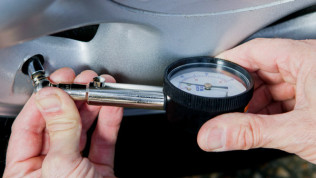You and your passengers depend on your tires for a secure ride. Stay safe and save money by regularly maintaining your tires.
The National Highway Traffic Safety Administration provides a wealth of tire safety information, including tips for purchasing and maintaining tires. Here are five common questions and answers about tire safety.
WHAT IS THE MOST IMPORTANT PART OF MAINTAINING MY TIRES?
Whether whitewall or blackwall, all-season or snow tires, every brand benefits from proper tire pressure, the most important maintenance checkpoint. The NHTSA recommends keeping a tire pressure gauge in your car to check pressure at least monthly. Over- or underinflated tires can be a safety hazard and affect gas mileage.
To find the correct tire inflation level for your vehicle, check the owner’s manual or read the Tire and Loading Information Label (select Tire Pressure on this page) on the driver’s side door jamb or frame. The proper pressure is not necessarily that shown on the tire. Check once a month, whenever you hit a curb or pothole and when the tire monitoring system alerts you to low pressure. Don’t forget the spare. Some cars are now equipped with an emergency inflation device, which also requires routine maintenance.
WHAT IS THE BEST TIRE GAUGE TO USE FOR MEASURING TIRE PRESSURE?
There are three basic types – stick, digital and dial. While “old school,” the stick type is inexpensive, quick and easy to use and quite reliable if it’s clean and dry. Digital gauges are fine – a bit more expensive, require batteries and are more sensitive to being dropped. An analog dial gauge is between the other options in cost and impact damage. But both the digital and dial gauges are easier to read and less prone to error from dirt and moisture.
HOW DO I KNOW WHEN IT’S TIME TO REPLACE THE TIRES?
Check the depth of the tread and replace worn tires immediately.
Your tread is what grips your car to the road and provides traction to prevent slipping and sliding. Replace your tire when the tread is worn down to 2/32 of an inch; when wear indicators are visible or when it no longer passes the “penny test.” Put a Lincoln head penny in the tread, head down and facing you. If you can see the top of Lincoln’s head, it’s time to replace the tire.
SHOULD I BE CONCERNED ABOUT THE AGE OF THE TIRE?
Yes. Tires degrade over time. What looks, smells and feels brand new may actually be an unsafe tire. It’s not unusual for discounted new tires to be a couple of years old even though unused. To determine a tire’s age, check the sidewall of the tire for the manufacturing code telling the week and year the tire was made. Some manufacturers recommend replacing tires that are more than six to 10 years old, regardless of wear.
HOW DO I KNOW IF MY TIRES HAVE BEEN RECALLED?
Like any other consumer product, tires can be recalled because of manufacturing defects. Stay informed and register your new tires with the manufacturer to receive product notices and alerts. You can also sign up to receive tire recall notices and alerts from the National Highway Traffic Safety Administration and search for recalls or check online for ongoing NHTSA investigations. If you experience a problem with your tires, you can help protect others by reporting safety issues.
This loss control information is advisory only. The author assumes no responsibility for management or control of loss control activities. Not all exposures are identified in this article.

